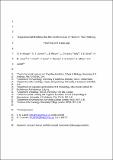Files in this item
Experimental evidence for the co-evolution of hominin tool-making teaching and language
Item metadata
| dc.contributor.author | Morgan, T. J. H. | |
| dc.contributor.author | Uomini, N. T. | |
| dc.contributor.author | Rendell, L. E. | |
| dc.contributor.author | Chouinard-Thuly, L. | |
| dc.contributor.author | Street, S. E. | |
| dc.contributor.author | Lewis, H. M. | |
| dc.contributor.author | Cross, C. P. | |
| dc.contributor.author | Evans, C. | |
| dc.contributor.author | Kearney, R. | |
| dc.contributor.author | de la Torre, I. | |
| dc.contributor.author | Whiten, A. | |
| dc.contributor.author | Laland, K. N. | |
| dc.date.accessioned | 2015-07-12T23:10:39Z | |
| dc.date.available | 2015-07-12T23:10:39Z | |
| dc.date.issued | 2015-01-13 | |
| dc.identifier | 168639052 | |
| dc.identifier | 58c96741-6f93-427e-a97f-0fa77bbdb760 | |
| dc.identifier | 84922986381 | |
| dc.identifier | 000348829800007 | |
| dc.identifier | 25585382 | |
| dc.identifier.citation | Morgan , T J H , Uomini , N T , Rendell , L E , Chouinard-Thuly , L , Street , S E , Lewis , H M , Cross , C P , Evans , C , Kearney , R , de la Torre , I , Whiten , A & Laland , K N 2015 , ' Experimental evidence for the co-evolution of hominin tool-making teaching and language ' , Nature Communications , vol. 6 , 6029 . https://doi.org/10.1038/ncomms7029 | en |
| dc.identifier.issn | 2041-1723 | |
| dc.identifier.other | RIS: urn:573B7BD250199C745669F1858CE80641 | |
| dc.identifier.other | ORCID: /0000-0001-8110-8408/work/60427416 | |
| dc.identifier.other | ORCID: /0000-0002-1121-9142/work/27612540 | |
| dc.identifier.other | ORCID: /0000-0002-2457-0900/work/60630325 | |
| dc.identifier.other | ORCID: /0000-0003-2426-5890/work/65013968 | |
| dc.identifier.uri | https://hdl.handle.net/10023/6970 | |
| dc.description | Research supported in part by an ERC Advanced Grant to K.N.L. (EVOCULTURE, ref: 232823) and grants to N.T.U. from the British Academy (Centenary Project ‘Lucy to Language: the Archaeology of the Social Brain’) and the Leverhulme Trust (ECF 0298). | en |
| dc.description.abstract | Hominin reliance on Oldowan stone tools—which appear from 2.5 mya and are believed to have been socially transmitted—has been hypothesized to have led to the evolution of teaching and language. Here we present an experiment investigating the efficacy of transmission of Oldowan tool-making skills along chains of adult human participants (N=184) using five different transmission mechanisms. Across six measures, transmission improves with teaching, and particularly with language, but not with imitation or emulation. Our results support the hypothesis that hominin reliance on stone tool-making generated selection for teaching and language, and imply that (i) low-fidelity social transmission, such as imitation/emulation, may have contributed to the ~700,000 year stasis of the Oldowan technocomplex, and (ii) teaching or proto-language may have been pre-requisites for the appearance of Acheulean technology. This work supports a gradual evolution of language, with simple symbolic communication preceding behavioural modernity by hundreds of thousands of years. | |
| dc.format.extent | 8 | |
| dc.format.extent | 1025696 | |
| dc.language.iso | eng | |
| dc.relation.ispartof | Nature Communications | en |
| dc.subject | Tool-use | en |
| dc.subject | Human evolution | en |
| dc.subject | Social transmission | en |
| dc.subject | Language evolution | en |
| dc.subject | QH301 Biology | en |
| dc.subject | NDAS | en |
| dc.subject | BDC | en |
| dc.subject | R2C | en |
| dc.subject.lcc | QH301 | en |
| dc.title | Experimental evidence for the co-evolution of hominin tool-making teaching and language | en |
| dc.type | Journal article | en |
| dc.contributor.sponsor | European Research Council | en |
| dc.contributor.institution | University of St Andrews. School of Biology | en |
| dc.contributor.institution | University of St Andrews. Sea Mammal Research Unit | en |
| dc.contributor.institution | University of St Andrews. Marine Alliance for Science & Technology Scotland | en |
| dc.contributor.institution | University of St Andrews. Bioacoustics group | en |
| dc.contributor.institution | University of St Andrews. School of Psychology and Neuroscience | en |
| dc.contributor.institution | University of St Andrews. ‘Living Links to Human Evolution’ Research Centre | en |
| dc.contributor.institution | University of St Andrews. Institute of Behavioural and Neural Sciences | en |
| dc.contributor.institution | University of St Andrews. Centre for Social Learning & Cognitive Evolution | en |
| dc.contributor.institution | University of St Andrews. Scottish Oceans Institute | en |
| dc.contributor.institution | University of St Andrews. Centre for Biological Diversity | en |
| dc.identifier.doi | 10.1038/ncomms7029 | |
| dc.description.status | Peer reviewed | en |
| dc.date.embargoedUntil | 2015-07-13 | |
| dc.identifier.grantnumber | en |
This item appears in the following Collection(s)
Items in the St Andrews Research Repository are protected by copyright, with all rights reserved, unless otherwise indicated.

